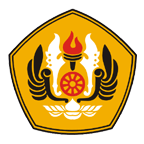Acute Toxicity Test of Pineapple Peel Aqueous Extract (Ananas comosus L.) With BSLT Method
Abstrak
Pineapple peel waste can be processed into pharmaceutical dosage form, but research related to the toxicity of pineapple peel is still limited. Based on the LC50 value and the description of morphological damage in Artemia salina larvae, this study seeks to establish the acute toxicity of pineapple peel aqueous extract. The method used is the Brine Shrimp Lethality Test (BSLT). Preliminary tests were carried out using each of 10 Artemia salina larvae in 10 mL of pineapple peel water extract at concentrations of 10000;1000;100;10;1; 0.1 ppm. Based on the results of the preliminary test, the definitive test was conducted with seven concentration variations, plus a saltwater negative control and a potassium dichromate 39.06 ppm positive control. After 24 hours, observations were performed on the number of deaths and morphological damage of Artemia salina larvae. An LC50 value will be generated by performing a probit analysis on data regarding the number of larvae deaths using Microsoft Excel. A morphological damage of Artemia salina larvae were analyzed descriptively. Results of the preliminary test are presented as concentration ranges for the final test, including 100, 251, 630, 1583, 3975, 6987, and 10,000 ppm. The LC50 value obtained based on the definitive test was 1185 ppm. Morphological damage to Artemia salina larvae due to exposure to water extract of pineapple peel occurred in the antenula, appendages, abdomen, and digestive tract. Pineapple peel water extract belongs to the non-toxic category with LC50 value is > 1000 ppm. Morphological damage to Artemia salina larvae occurred at concentrations of 630-10000 ppm.
Kata Kunci
Teks Lengkap:
PDFReferensi
Food and Agriculture Organization. World production quantity pineapples 2020 [Internet]. 2020 [cited 2022 September 1]. Available from:https://fao.org/faostat/en/#data/QC
Badan Pusat Statistik. Produksi buah-buahan 2020 [Internet]. 2020 [cited 2022 September 1]. Available from:http://www.bps.go.id/indicator/55/62/produksi-tanaman-buah-buahan.html
Sandika, A. S., Muria, S. R. & Yenti, S. R. Fermentasi kulit nanas menjadi bioetanol menggunakan zymomonas mobilis dengan variasi pemekatan medium dan waktu fermentasi. Jurnal Online Mahasiswa Fakultas Teknik. 2017;4(1).
Suhartini, S., & Nurika I. Teknologi pengolahan limbah agroindustri. Malang: UB Press; 2018.
Rabiu, Z., Maigari, F.U., Lawan, U., & Mukhtar, Z.G. Pineapple waste utilization as a sustainable means of waste. Singapore City: Springer Nature; 2018.
Salve, R.R., & Ray, S. Green extraction of polyphenolics as potential bioactive components from pineapple skin: a review. Research Journal of Pharmaceutical, Biological and Chemical Sciences. 2021;12(2).
Damiyati, S.Y., Pratama, I.S., & Tresnani, G. In vitro anthelmintic activity of pineapple peel juice (ananas comosus (l.) Merr.) Against paramphistomum sp. Communications in Science and Technology. 2021;6(1).
Guha, R. Preclinical pharmacology and toxicology: an important aspect in drug discovery. Advances in Clinical Toxicology. 2016;1(1).
Klaassen C, & Watkins J. Casarett & doull's essentials of toxicology. 4th ed. New York: McGraw Hill Education; 2021.
Colegate S.M., & Molyeneux R.J. Bioactive natural products detection, isolation, and structural determination. 2nd ed. Florida: CRC Press; 2008.
Evangelista, J. H., Vera, M. J. De, Garcia, R. S., Joven, M. G., & Solidum, J. N. Preliminary assessment of in vitro anticoagulant activity vs heparin 1000 iu and cytotoxicity of selected philippine medicinal plants. International Journal of Chemical and Environmental Engineering Preliminary. 2012;3(6).
Paixao, J.A.D., Neto, J.F.D.A., Nascimento, B.O.D., Costa, D.M.D., Brandao, H.N., Souza, F.V.D., Alves, Q.L., Erling, S.B.L., & David, J.P.D.L. Pharmacological actions of ananas comosus l. merril: revision of the works published from 1966 to 2020. Pharmacognosy Reviews. 2021;15(29).
Sarah, Q. S., Anny, F. C., & Misbahuddin, M. Brine shrimp lethality assay. Bangladesh Journal of Pharmacology, 2017;12(2).
Vanhaecke, P., Persoone, G., Claus ,C., & Sorgeloos, P. Proposal for a short-term toxicity test with artemia nauplii. Ecotoxicology and Environmental Safety. 1981;5(3).
Lazuardi, M. Bagian umum ilmu farmasi veteriner. Jakarta: Ghalia Indonesia; 2016.
Ngakan O.P., Nasri N., Hamzah A.S., Wahyudi., Karim H.A., & Maulany R.I. Dendrologi: dasar-dasar mengenal pohon. Makassar: Fakultas Kehutanan Universitas Hasanuddin; 2022.
Hamidi, R.M., Jovanova, B., & Kadifkova, P.T. Toxicological evaluation of the plant products using brine shrimp (artemia salina l.) Model. Macedonian Pharmaceutical Bulletin. 2014;60(1).
Obregon E.B., & Vargas A. Chronic toxicity bioassay with populations of the crustacean artemia. Biol Res. 2010;43.
Mounts, I.D. Metholds for aquatic toxicity identification evaluations. Minnesota: National Effluent Toxicity Assesment Center;1989.
Hair J.F., Black W.C., Babin B.J., & Anderson R.E. Multivariate data analysis. New York: Prentice Hall; 2011.
Lind A., Douglas, Wiliam G. Marchal, & Samuel A.W. Statistical techniques in bussiness & economics. New York: Mc Graw Hill; 2005.
Tighe, J., McManus, I. C., Dewhurst, N. G., Chis, L., & Mucklow, J. The standard error of measurement is a more appropriate measure of quality for postgraduate medical assessments than is reliability: an analysis of mrcp(uk) examinations. BMC Medical Education. 2010;10(1).
Ayoub, N., Kaouthar, E. B., Soumaya, R., Chaimaa, M., Nadia, I., & Souad, E. A. Evaluation of the effects of three chemical fertilizers on artemia salina. Journal of Ecological Engineering. 2023; 24(5).
Silva, R. M. D., Miguel, T. B. A. R., de Castro Miguel, E., Campelo, P. H., Fernandes, F. A. N., & Rodrigues, S. Protective effect of ultrasound-processed amazonian sapota-do-solimões (quararibea cordata) juice on artemia salina nauplii. Processes. 2022;10(9),
Abatzopoulos, T.J., Beardmore, J.A., Clegg, J.S., & Sorgeloos, P. Artemia basic and applied biology. Berlin: Springer; 2002.
Lo Nostro, P., Ninham, B.W., Carretti, E., Dei, L., & Baglioni, P. Specific anion efeects in artemia salina. Chemosphere.2015;335.
Najla, M. A., Syaizwan, Z.Z., Ahmad I., Azmai N.M.A., & Yusuf F.M. Selected morphological changes in nauplii of brine shrimp (artemia salina) after tributyltin chloride (tbtcl) exposure. World Applied Sciences Journal, 2015;33(8).
DOI: https://doi.org/10.24198/ijpst.v12i1.48332
Refbacks
- Saat ini tidak ada refbacks.
| Switch to English Back to Top |
| View My Stats Penerbit Universitas Padjadjaran
Jurnal ini terindeks di :Creative Commons Attribution :
Based on a work at http://jurnal.unpad.ac.id/ijpst/ |
 Indonesian Journal of Pharmaceutical Science and Technology
Indonesian Journal of Pharmaceutical Science and Technology




